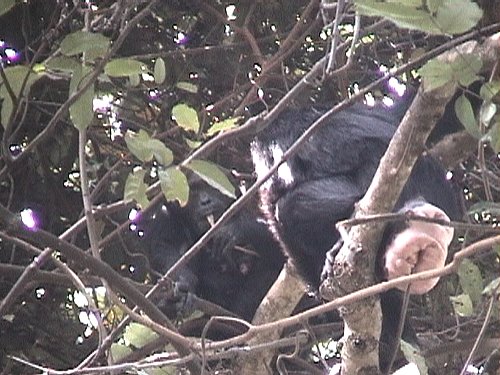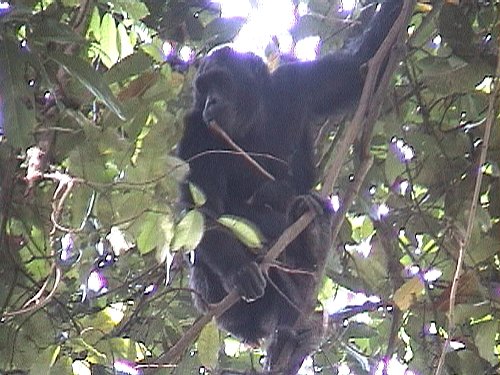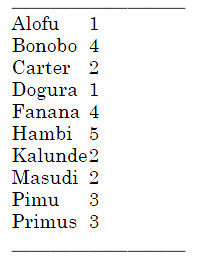|
<NOTE>
A Wild Chimpanzee Birth at Mahale
Koichiro Zamma1,3, Tetsuya Sakamaki2,3 & Rashidi Shabani Kitopeni3
1. Great Ape Research Institute, Hayashibara, Japan 2. Primate Research Institute, Japan 3. Mahale Mounatins Chimpanzee Research Project INTRODUCTION Wild chimpanzee births are difficult to observe because females tend to hide during the birthing process to avoid others1, 2. On 26 May 2000, Juno, a female chimpanzee at Mahale Mountains National Park, Tanzania, gave birth. Although we did not see the exact moment of birth, we report our observations of her behavior immediately before and after the birth. OBSERVATIONS Before birth At 08:14 on 26 May 2000, we began to observe the chimpanzees of M group in Mahale. At 08:21, one researcher (KZ) started to follow an adult male called Kalunde. Around 08:30, Juno appeared uttering pant-grunts to Kalunde. She then climbed a tree and lay on a day bed made of one branch. The chimpanzees moved north and ate the fruit of Psydrax parviflora or Uvaria angolensis. At 11:46, Juno reappeared. She crouched on the ground in front of Kalunde, and he began to groom her. After a few seconds, Alofu, an adult male, approached and peered at Juno’s genitals. Kalunde also tried to peer at them, but she turned around once to prevent this. Her genital skin was not swollen, seemed dry, and showed no sign that her water had broken. She had not given birth at that time. When Juno lay on her left side, Alofu and Kalunde examined her genitals for 13 seconds. Subsequently, she lay on her back, and the males started grooming her. She did not reciprocate the grooming. At 11:47, Juno rolled over and lay on her left side, and then again lay on her back at 11:48. Alofu changed his position to follow her genitals. At 11:49, Juno lay on her left side again, and at 11:51 she turned around and crouched. Alofu changed his position again, following her genitals, and he and Kalunde continued to groom her. At 11:57, Kalunde stopped grooming and lay in the same location, but Alofu continued to groom Juno. At 12:01, Kalunde groomed Alofu for a short time and then left. When KZ left, following Kalunde, Juno was still being groomed by Alofu. After birth When a researcher (RK) observed Juno in the tree at 14:44, she was already nestling her newborn in her arms. RK had followed his focal animal, Masudi (an adult male), to the location and he also found Alofu on the ground. Juno climbed down from the tree, uttered pant-grunts to Alofu, and climbed another tree. Then, Fanana (the alpha male) came to the tree, displayed, and charged Juno. She screamed and climbed higher. After Fanana left, Juno made a bed and started to rest. At 15:03, researchers KZ and TS arrived at the tree while following their focal animals. TS had been following an adult male chimpanzee named Bonobo since that morning. Juno appeared from the bed with her newborn and touched her genitals five times while sat on a branch 20 m above the ground. KZ took video on it using SONY DCR-PC7. Four adult females (Caliope, Totzy, Nkombo, and Zola), an adult male (Carter), and four immature chimpanzees (Primus, Ivana, Jidda, and Christmas) watched Juno in the tree. Caliope was a multiparous female with a 2-year-old offspring, and Totzy, Nkombo, and Zola were nonparous females with swollen genitals. Jidda was the 5-year-old offspring of Juno. At 15:05, Juno put the end of the umbilical cord in her mouth and pulled on it as if she was trying to the suck fluid inside it (Figure 1, Video 1: available online at mahale.main.jp/PAN/19_1/19(1)_02.html). The umbilical cord was about 40 cm long and the other end was connected to her newborn. The placenta was not observed. Then, Juno moved on woody vines while holding the umbilical cord in her mouth (Figure 2). The newborn was clinging to her abdomen, held there with Juno’s thigh and hand. Primus stared at Juno from a distance of 3 m. At 15:07, Juno defecated and urinated, then lay on her back on a woody vine. When Caliope approached Juno while fleeing from Primus, Juno uttered soft barks and moved on the tree while holding the umbilical cord in her mouth. At 15:09, Primus and Carter started to display in the tree, but they hastily climbed down and uttered pant-grunts to Fanana, who had appeared beneath the tree. Carter also uttered pant-screams to Fanana, and then Juno and another chimpanzee uttered pant-hoots. At 15:12, Fanana left the location and some of the other chimpanzees also started to leave the tree. At 15:21, Caliope also left. Juno uttered “hu, hu” and the newborn uttered “fa, ha-ha.” The newborn was female. Video 1. 
Figure 1. Juno (left) and her newborn. Totzy (right) watched them. 
Figure 2. Juno and the umbilical cord. Terrestrial movement At 15:23, Juno descended the tree and walked on the ground with her newborn, which she held with her right hand. A researcher (TS) followed her. At 15:25, Juno shifted to holding her newborn with her left hand and walked tripedally while trailing the umbilical cord. She passed in front of Masudi uttering pant-grunts, and sat on the ground. Masudi approached Juno from behind. She showed a grin face while uttering soft pant-grunts. She looked frightened. Masudi stood quadrupedally and peered at her from a distance of 10 cm. At this time, Pimu (an adolescent male) approached and sat in front of Juno. When Juno left, Pimu attacked her back. Juno ran away uttering screams and barks. Pimu left, while displaying. Caliope came to Juno’s side, like a guard, uttering vocalizations. Juno and Caliope walked together in a different direction from the others. At 15:30, Caliope had left and Juno walked alone. She ate U. angolensis fruit. She pulled the umbilical cord with her right hand. At 15:42, she lay on her back. The newborn sucked Juno’s left nipple. When the newborn almost slid off, Juno held her up. The newborn uttered “hu, hu.” At 15:44, Juno sat up. TS heard the vocalizations of other chimpanzees some distance away. At 15:52, Juno picked up the umbilical cord and the newborn uttered “hu, hu.” At 15:53, Juno put the umbilical cord in her mouth and chewed on it. At 15:57, Juno started to walk with the newborn, trailing the end of the umbilical cord. At 15:58, she entered a thick bush and TS stopped following her. We observed 50/51 individuals in M group that day. Examination of the bed At 15:56, researcher KZ climbed up to observed the empty bed. It was 80 cm in diameter and the placenta was not found on it. DISCUSSION Juno gave birth between 12:01 and 14:44 on 26 May 2000 while moving with almost all members of her unit group. Wild chimpanzee births are observed extremely rarely1–3. Juno immigrated in 1987 and had given birth to four offspring (MMCRP unpublished data). She had spent a long time in M group and had given birth many times, so she might have had the confidence to give birth the fifth time in broad daylight. The umbilical cord was observed, but the placenta was not found. Previous reports of chimpanzee births have described the delivery of the placenta 13–18 minutes after birth, and the mother’s consumption of it beginning 0–4 minutes later1,3. Juno must have eaten the placenta shortly after she delivered. Based on a 229-day gestation period4, Alofu was the likely father of Juno’s offspring because only Juno and Alofu were not observed from 26 September to 11 October 2000 and were thought to have formed a consortship. However, Juno was observed to copulate at least 27 times with 10 males subsequently (Table 1. TS unpublished data), so the paternity was confused among these males. Because the males had the idea that they were the father of her newborn, they may not have delivered terrible attack on Juno and her newborn though some of them displayed near Juno and charged her. Table 1. The partners and number of copulations with Juno observed from November to December 2000 (TS unpublished data). 
It is interesting that Alofu, the probable father, spent time peering at Juno’s genitals before the birth, although they were not swollen and lacked any visible sign of parturition. The urinary estrone conjugate (E1C) of female chimpanzees peaks during genital swelling and just before birth, whereas urinary pregnandiol glucuronide (PdG) remains at low levels during swelling and increases just before parturition5. Alofu may have smelled an odor indicating swollen genitals or imminent parturition. ACKNOWLEDGEMENTS We thank TAWIRI, TANAPA and COSTECH for permission of our fieldworks, Rashidi H, Mtunda M, Hamisi B, and other member of MMCRP for their help in the field, and Fujita S, Nakamura M, Hosaka K and Itoh N for their valuable comments. This study was financially supported by grants from the COE program of Monbusho (#10CE2005 to O. Takenaka) and the Leakey Foundation (to T. Nishida). REFERENCES
Back to Contents |